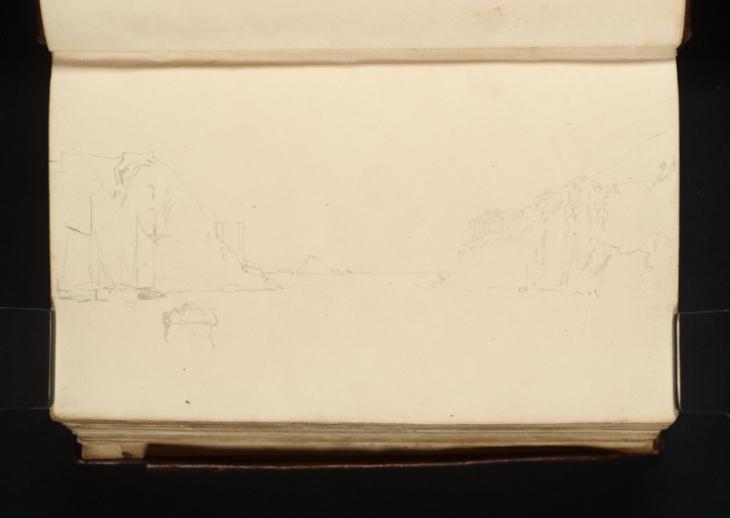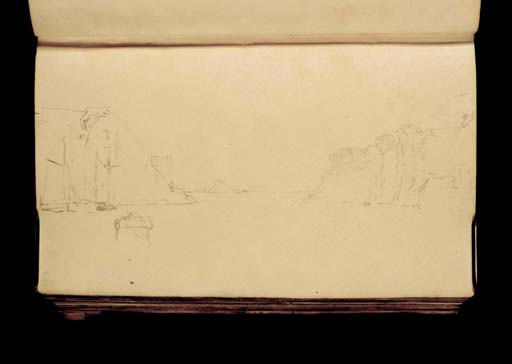Joseph Mallord William Turner Plymouth Sound: Devil's Point and Mount Edgcumbe with the Great Mew Stone in the Distance 1813
Image 1 of 2
Joseph Mallord William Turner,
Plymouth Sound: Devil's Point and Mount Edgcumbe with the Great Mew Stone in the Distance
1813
Joseph Mallord William Turner 1775–1851
Folio 275 Verso:
Plymouth Sound: Devil’s Point and Mount Edgcumbe with the Great Mew Stone in the Distance 1813
D09476
Turner Bequest CXXXI 186a
Turner Bequest CXXXI 186a
Pencil on white wove paper, 95 x 157 mm
Accepted by the nation as part of the Turner Bequest 1856
References
1909
A.J. Finberg, A Complete Inventory of the Drawings of the Turner Bequest, London 1909, vol.I, p.372, CXXXI 186a, as ‘Vessels at mouth of river’.
With the page turned horizontally, the view is to the south-east at water level across the full expanse of Plymouth Sound, focusing on the Great Mew Stone off Wembury Point in the distance. There is a similar view from a little further south on folio 274 verso (D09474; CXXXI 185a).
This is the first of a sequence of drawings working in from the back of the sketchbook, which correlate with the journalist Cyrus Redding’s retrospective accounts of a voyage with Turner and others south across Plymouth Sound, out past the Mew Stone and thence eastwards along the coast to Burgh Island in Bigbury Bay. After a night at Kingsbridge, there followed a return journey by land to Boringdon Park, overlooking the Laira (Plym Estuary) near Saltram House, east of Plymouth (for Redding and more of his reminiscences of Turner in Devon see the Introduction to the tour). Assuming the sequence is a continuous one made on their journey, it may extend as far as the view of Plymouth Citadel on folio 228 verso (Tate D09382; Turner Bequest CXXXI 139a), or the last few may relate to their stay at Saltram the next day (again, see the tour Introduction).
Redding gives a detailed account of the voyage, to culminate in a prospective meal of ‘hot lobsters ... just taken from the sea’, in a ‘Dutch boat, a famous sea-going craft, with the usual outriggers’ belonging to a Captain Nicols, along with ‘an artist, named Demaria, ... and a military officer’.1 James Demaria was a scene painter at the Opera House in London, whom Turner may already have known, and the young David Cox had worked under him in Birmingham around 1800.2 Redding continues:
The morning did not look very propitious: there was a heavy swell rolling into the sound, and the wind rising. The sea had that dirty, perturbed appearance which is sometimes the forerunner as well as the follower of a gale. We worked out into the sound, where the breakwater had been just commenced, keeping towards Penlee and Rame-head [see folio 265 verso; D09456; CXXXI 176a], to obtain an offing. As soon as we saw we were clear of the nearer headlands on the east, we got well off the land, and while still running to the eastward, the sea rose higher. Off Stoke’s point it became very boisterous; but our boat mounted the ridges bravely.3
Turner nevertheless enjoyed the voyage, and ‘looked on with most artistic watchfulness. When we were on the crest of a wave, he now and then articulated to myself–for we were sitting side by side– ‘That’s fine!– fine !’ Demaria was very ill and art [was] driven out of his head; the soldier was groaning and spoiling his scarlet coat, extended upon the rusty ballast in the bottom of the boat.’4
When we were off the island, and saw the sea breaking upon it, there seemed no possibility of our landing, the line of white surf being connected and unbroken. There was a river called the Avon within the island, running up the main; we made towards it, and getting under the lee of the island, landed without much difficulty, with a little wetting. All this time I could see Turner silently glancing over the boisterous scene. The little island and solitary house or hut upon it, the bay in the bight of which they lay, and the Bolthead stretching darkly to seaward, against the precipitous rocky shore of which the sea broke furiously – all formed a striking scene, and Turner thought so. While the unfortunate shell-fish were preparing to be seethed, I missed Turner, and found him, with a pencil and small book, near the summit of the island. I observed, too, he was [or, in the 1858 and 1866 accounts, ‘seemed’] writing rather than drawing. The tumultuous waves boiling below were seen to great advantage from thence. I imagined he had observed something novel in their appearance, but this, whatever it might be, I did not comprehend. We soon sat down to our repast, to which the artist did ample justice.5
For Burgh Island and the adjacent coast see between folios 260 verso and 253 verso (D09446 and D09432; CXXXI 171a, 164a). Rather than return with Captain Nicols in the boat on rough seas at night, the party walked several miles inland to spend the night at Kingsbridge (see folio 252 verso; D09430; CXXXI 163a).6 Redding noted that the next morning they travelled from there:
to see the house, at Dodbrook, in which Dr. Walcot (Peter Pindar) [John Wolcot (sic), 1738–1819, poet and satirist7] was born. The artist made a sketch of it [in the 1866 account: ‘Walcot sold it, and there had been a new house erected there since; of this the artist took a sketch.’] and of another house, a picturesque place not far distant. We had now more than twenty miles to travel home. A vehicle was provided, but we walked much of the way, for Turner was a good pedestrian, capable of roughing it in any mode the occasion might demand.’8
Eventually they neared Plymouth:
‘When we came to the La[i]ra passage, we met Lord Boringdon (afterwards Earl of Morley), who invited Turner, Demaria, and myself to Saltram, to dine and sleep, the following day. We went accordingly. In the morning we ascended the high ground in the park, whence there is a fine view. There is also some fine scenery near the eastern entrance, at the mouth of the Plym, and Turner made some sketches here.’9
For Saltram, see the Introduction to the tour.
Matthew Imms
April 2014
Cyrus Redding, ‘The Late Joseph Mallord William Turner’, Fraser’s Magazine for Town and Country, vol.45, no.266, February 1852, p.152; see also other versions or quotations from Redding in Cyrus Redding, Fifty Years’ Recollections, Literary and Personal, with Observations on Men and Things, London 1858, vol.I,, p.199; Walter Thornbury, The Life of J.M.W. Turner, R.A. Founded on Letters and Papers Furnished by his Friends and Fellow-Academicians, London 1862 [1861], vol.I, p.202; Cyrus Redding, Past Celebrities Whom I Have Known, London 1866, vol.I, p.48; W[illiam] Cosmo Monkhouse, Turner, London 1882, p.80; Walter Thornbury, The Life of J.M.W. Turner, R.A. Founded on Letters and Papers Furnished by his Friends and Fellow-Academicians: A New Edition, Revised with 8 Coloured Illustrations after Turner’s Originals and 2 Woodcuts, London 1897, p.143; and Alexander J. Finberg, The Life of J.M.W. Turner, R.A. Second Edition, Revised, with a Supplement, by Hilda F. Finberg, revised ed., Oxford 1961, p.198; for a synopsis of Redding’s account see Eric Shanes, Turner’s Rivers, Harbours and Coasts, London 1981, p.7.
See Finberg 1961, p.200; and Jack Lindsay, J.M.W. Turner: His Life and Work: A Critical Biography, London 1966, pp.70, 149, 227 note 1.
Redding 1852, p.152; see also Redding 1858, I, pp.199–200; Thornbury 1862, I, p.202; Redding 1866, vol.I, p.48; Monkhouse 1882, p.80; Thornbury 1897, p.144; and Finberg 1961, p.198.
Redding 1852, p.152; see also Redding 1858, I, p.200; Thornbury 1862, I, p.203; Redding 1866, vol.I, p.48; Monkhouse 1882, p.80; Thornbury 1897, p.144; and Finberg 1961, p.198.
Redding 1852, p.152; see also Redding 1858, I, p.200; Thornbury 1862, I, pp.203, 208; Redding 1866, vol.I, p.49; Monkhouse 1882, p.82; Thornbury 1897, p.144; and Finberg 1961, p.199.
Redding 1852, p.152; see also Redding 1858, I, pp.200–1; Thornbury 1862, I, pp.203–4, 208–9; Redding 1866, vol.I, p.50; Thornbury 1897, p.144; and Finberg 1961, p.199.
See William R. Jones, ‘Wolcot, John (bap. 1738, d. 1819)’, Oxford Dictionary of National Biography, accessed 8 Dec 2011, http://www.oxforddnb.com/view/article/29828 .
Redding 1852, p.153; see also Redding 1858, I, p.201; Thornbury 1862, I, pp.204, 209; Redding 1866, I, pp.50–1; Monkhouse 1882, p.82; Thornbury 1897, p.145; and Finberg 1961, p.199.
How to cite
Matthew Imms, ‘Plymouth Sound: Devil’s Point and Mount Edgcumbe with the Great Mew Stone in the Distance 1813 by Joseph Mallord William Turner’, catalogue entry, April 2014, in David Blayney Brown (ed.), J.M.W. Turner: Sketchbooks, Drawings and Watercolours, Tate Research Publication, September 2014, https://www


